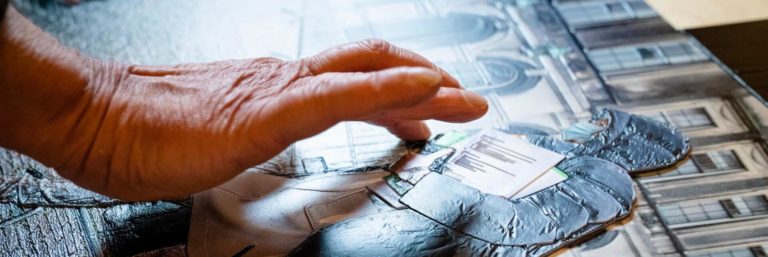Museums naturally want everyone to enjoy their exhibitions, but how do you ensure that the blind and visually impaired can ‘see’ a photograph? Reason for Museum Hilversum, together with photographic designer Daphne Wageman and Canon, to investigate whether and how you can visualize a photo by printing it in layers, creating relief. Last month, in the presence of Bart Maat, his winning photo “Function elsewhere” was tested.

‘A combination of auditory information and touch gives an Aha’
Daphne Wageman and Clemens Weijkamp of Canon Production Printing worked closely together on the relief and texture design of the photo. They made softproofs, both in matt black and in full colour, using the Canon Touchstone 3D viewer for Adobe Photoshop and they investigated how the photo could be constructed so that a blind or visually impaired person could extract information from it. Wageman, by the way, speaks from experience. After she was temporarily (completely) blind due to a spot on her eye, she presented an exploration of the experiences of visually impaired people in the exhibition “Blindsight”.

The test
Hannes Wallrafen, audiographer and former photographer, Ron van der Genugten, initiator of the Eye Café, and Tim in ‘t Veld, Expert on mobility, all three live with visual impairment. After being given a description, they set to work with the layered photograph. While Ron indicates that his main concern is the subject matter, Tim indicates that feeling is difficult because, for example, you don’t recognize a piece of a car as a car. Information about this is important. “A combination of auditory information and feeling gives an Aha”, Wallrafen concludes. “Besides context, a description, such as a big step, wet weather, long boots, coat, direction left, is also important. Then you start to explore, get a combination and then it really adds value.” Other tips when selecting images include simplicity in the image, relief height and making the accompanying information easily accessible to the target audience.


Silver Camera
“With news photos, we are aware of the world around us,” said museum director Stef van Breugel. “That is why we would like to realise this pilot at the new exhibition Silver Camera, the most important journalistic photo competition in the Netherlands. An exhibition that will travel around the country and thus be experienced by more people. Our enthusiasm about a possible beautiful enrichment of the exhibition with tangible images was fortunately shared by the three real experience experts Hannes, Ron and Tim. There is still work to be done, though, as we need to work on their areas for improvement.”







